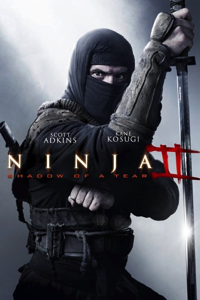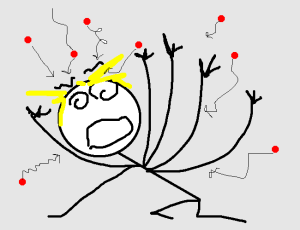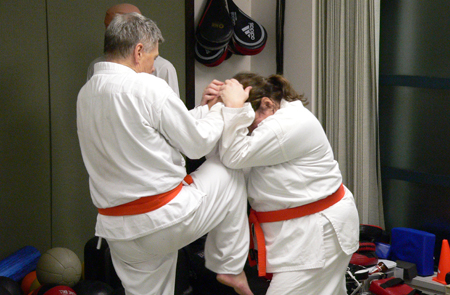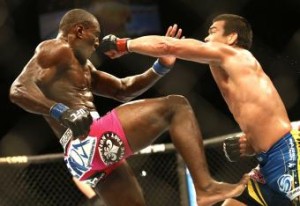How to Adopt New Healthy Habits
Almost everyone I’ve ever met has a desire to adopt new healthy habits, whether it’s establishing a regular exercise routine, eating healthier, meditating or quitting smoking, reducing drinking, minimizing TV/Internet use, etc. It is readily accepted that it takes at least 30 days to establish a new healthy habit or remove a negative one. Here is a TedTalk discussing how 30-day challenges can change your life:
Matt Cutts says that if you really want something badly enough, you can do anything for 30 days. I believe this is true, as I discussed in my blog post How to Move Past Excuses & Start Living the Life You Choose, but in wanting it, you might have to find ways that make you stick to it, ones that are personal to you. (more…)
5 Reasons We Resist the Practice of Meditation (& How to Deal with Them)
 Of all the healthy habits I’ve introduced in my life over the years, meditation is one that has had the greatest impact. With only 20 minutes of daily sitting, focusing on my breath and letting go of busy thinking, I have found that I think more clearly, work more productively, exert greater control over my emotional states, and am more grounded in all aspects of my life and my endeavours.
Of all the healthy habits I’ve introduced in my life over the years, meditation is one that has had the greatest impact. With only 20 minutes of daily sitting, focusing on my breath and letting go of busy thinking, I have found that I think more clearly, work more productively, exert greater control over my emotional states, and am more grounded in all aspects of my life and my endeavours.
Doctors and scientists have compiled plenty of research that confirms a wide variety of benefits, including reduced stress, improvements in mental conditions (anxiety, depression, ADHD, etc), reduced incidences of illness, enhanced creativity, increased productivity, and more besides. Read more about the benefits of meditation in this detailed list from Psychology Today. With all these documented benefits, one might wonder why more people don’t adopt meditation as a habit. There are many reasons why as a society, we aren’t so inclined to try it or maintain it. Here are some of the issues we face and how to deal with them:
NINJA II: Shadow of a Tear – Movie Review
 This is a movie that at no point was on my radar until I received the request to review it. Which is unusual for movies that claim amazing martial arts action.
This is a movie that at no point was on my radar until I received the request to review it. Which is unusual for movies that claim amazing martial arts action.
I really wanted to title this review NINJA 2: The Re-Ninja-ing but as I’ve not seen the first one, it seemed unfair.
However, I can probably guess what happened in the first one based on the second one. Guy who trains and gets some ninja skills has some predictable reason to kill a bunch of people using said skills, probably in a particular showy manner, but with efficiency, often multiple attackers at once. Eventually he fights a previously introduced villain with whom he engages in a lengthy one-on-one battle in which he is grievously injured, but manages to prevail regardless.
I’m guessing that’s what happens in the first one because the second one could be described like that with the addition of the natural sequel plot. Our hero has settled down, presumably leaving behind some dark past, and his blissful domestic life is shattered causing him to seek revenge. Martial arts mayhem ensues.
Priming Witnesses: Look the Part when Defending Yourself
The last blog post of 2013, How to Look Like a Victim for Self-Defense generated a fair bit of discussion and raised some questions that I would like to take a bit of time to address a little more in-depth. There were of questions raised I would like to address specifically:
- Why do I need to do this at all, why can’t I just explain it afterwards, I’ve never been in trouble with the law before.
- Why would a smaller person attack larger people?
Why do I need to look like a victim?
In my line of work, the event security industry, we call this act priming witnesses. That means getting them aware of the context of the situation they are witnessing. When I need to remove someone from the premises for whatever reason, I take a calm measured approach, explain loudly and clearly why I need someone to leave (unless it would cause undue embarrassment on behalf of the subject, which could lead to a fight), and ask them to do so. I use a relaxed but ready stance, open hands. When force is required I give loud verbal commands, often in the phrase, “stop resisting,” or “get on the ground.” I make it clear I am only using physical force because the suspect is making it necessary.
(more…)
How to Look Like a Victim for Self-Defense
 Every person has different things to keep in mind when it comes to how their situation looks when using physical force to defend one’s self. Smaller women, like me, are more concerned with not looking like a victim, so we teach them how to carry themselves with confidence when walking about (more details in How to Avoid Looking Like an Easy Victim). We also teach them to make their psychological intention stronger to make it clear that they are not an ideal victim to their aggressors while simultaneously adding more force to their physical defense (more details in The Power of Intention in Self-Defense). But what about bigger, stronger men? Their situation is quite a bit different when it comes to how the situation looks, especially when it comes to bystanders.
Every person has different things to keep in mind when it comes to how their situation looks when using physical force to defend one’s self. Smaller women, like me, are more concerned with not looking like a victim, so we teach them how to carry themselves with confidence when walking about (more details in How to Avoid Looking Like an Easy Victim). We also teach them to make their psychological intention stronger to make it clear that they are not an ideal victim to their aggressors while simultaneously adding more force to their physical defense (more details in The Power of Intention in Self-Defense). But what about bigger, stronger men? Their situation is quite a bit different when it comes to how the situation looks, especially when it comes to bystanders.
Especially now when videos are easily taken with smart phones, bigger men have to be concerned with how they appear to potential witnesses when they use force to defend themselves. Even if they’re not the aggressor, and resort to reasonable physical tactics only to protect themselves, they might still be seen as the aggressor simply because they’re bigger, as many people only come to witness a fight after it’s already in progress, not having seen how it started in the first place. Add obvious combat training to their size and it makes it look worse. (more…)
The Benefits of Being an Uke for Belt Tests
 On the surface, being an uke or “beat-up dummy” for a belt test can seem like tough gig. The role of uke (Japanese for one who receives) involves holding pads for strikes and attacking the student testing so they can demonstrate their knowledge and abilities. But if you look past the surface, there are a number of benefits the uke receives while being hit, thrown and submitted.
On the surface, being an uke or “beat-up dummy” for a belt test can seem like tough gig. The role of uke (Japanese for one who receives) involves holding pads for strikes and attacking the student testing so they can demonstrate their knowledge and abilities. But if you look past the surface, there are a number of benefits the uke receives while being hit, thrown and submitted.
Julie Black Belt – Book Review
 Ok, quick disclaimer. This particular review and this product is really directed at parents of young children who are in the martial arts, or instructors of children. So if you’re not interested in illustrated books for children, then take a scroll through some of our other reviews, that cover things like self-defense and traditional martial arts books, or our ever popular Nutty Buddy review.
Ok, quick disclaimer. This particular review and this product is really directed at parents of young children who are in the martial arts, or instructors of children. So if you’re not interested in illustrated books for children, then take a scroll through some of our other reviews, that cover things like self-defense and traditional martial arts books, or our ever popular Nutty Buddy review.
This review really covers both books, even though the publisher originally asked me to review the sequel. The first book, entitled Julie Black Belt – The Kung Fu Chronicles is the first book and it takes our young protagonist Julie, and teaches her that it takes focus, patience and hard work to make progress in the martial arts.
Advice for People Starting a Martial Art Later in Life
 There are a lot of people who harbour a secret desire to train in a martial art, but don’t pursue it in earlier in life for whatever reason. As they age, after years of watching action movies or professional fighting, the notion creeps back into their minds in their 30s, 40s, 50s, even 60s. Most let themselves be talked themselves out of it, citing various reasons like “I’m too old to start an activity like that as a complete beginner,” or “My body just can’t take what it used to,” or “I’m just so out of shape, what’s the point?” Well, I’m here to say, it’s never too late if you approach it correctly.
There are a lot of people who harbour a secret desire to train in a martial art, but don’t pursue it in earlier in life for whatever reason. As they age, after years of watching action movies or professional fighting, the notion creeps back into their minds in their 30s, 40s, 50s, even 60s. Most let themselves be talked themselves out of it, citing various reasons like “I’m too old to start an activity like that as a complete beginner,” or “My body just can’t take what it used to,” or “I’m just so out of shape, what’s the point?” Well, I’m here to say, it’s never too late if you approach it correctly.
The thing is that there is some truth behind the cited reasons above, but it can be worked around. Here are 3 tips for on how to approach taking up martial training later in life: (more…)
How to Maximize Training Energy & Minimize Recovery
 I recently reached a bit of a plateau in my strength training regimen. I had made some decent progress in my strength over the past few months but a few weeks ago I was finding myself sore for several days after working out, with no improvements in my performance. I decided to seek out professional advice from a friend who is a personal trainer. He gave me two pieces of advice that made a huge difference:
I recently reached a bit of a plateau in my strength training regimen. I had made some decent progress in my strength over the past few months but a few weeks ago I was finding myself sore for several days after working out, with no improvements in my performance. I decided to seek out professional advice from a friend who is a personal trainer. He gave me two pieces of advice that made a huge difference:
1) Make sure you eat 0.3-0.6 grams of carbs per pound of body weight immediately after working out.
2) Don’t do your cardio training and strength training on the same day. (more…)
How to Develop Speedy Entries into Martial Arts Techniques
 There are a lot of great reasons for wanting to train speed of entry of martial arts techniques. Your initial reaction in a self-defense situation is vital to determining the outcome of the altercation. The first contact you make has the potential to completely turn the tables on your attacker, and vice versa, if you’re caught off guard and take a bad hit right off the top, it’s a lot more difficult to recover effectively. Speedy entry into techniques is equally important in the competitive martial arts arena. The faster you move into a technique, whether it’s a strike, throw/takedown or submission, the more likely you catch your opponent off-guard. Speedy entry, of course, is only one factor among many, but it is an important one.
There are a lot of great reasons for wanting to train speed of entry of martial arts techniques. Your initial reaction in a self-defense situation is vital to determining the outcome of the altercation. The first contact you make has the potential to completely turn the tables on your attacker, and vice versa, if you’re caught off guard and take a bad hit right off the top, it’s a lot more difficult to recover effectively. Speedy entry into techniques is equally important in the competitive martial arts arena. The faster you move into a technique, whether it’s a strike, throw/takedown or submission, the more likely you catch your opponent off-guard. Speedy entry, of course, is only one factor among many, but it is an important one.
For smaller stature people like me, the speed of entry and application of techniques helps make the best use our natural agility, and advantage we have over many larger/stronger attackers or opponents. Regardless of size, speed of entry helps the defender make better use of the element of surprise. It helps you stay one step ahead of your attacker or opponent, making it harder to mount a defense, whether through the use of strength or technique. There are lots of benefits to improving speed of entry, so below are a few tips for effectively applying and training this concept. (more…)


 We're proud to announce that Lori O'Connell Sensei's new book, When the Fight Goes to the Ground: Jiu-jitsu Strategies & Tactics for Self-Defense, published through international martial arts publisher Tuttle Publishing, is now available in major book stores and online. More about it & where to buy it.
We're proud to announce that Lori O'Connell Sensei's new book, When the Fight Goes to the Ground: Jiu-jitsu Strategies & Tactics for Self-Defense, published through international martial arts publisher Tuttle Publishing, is now available in major book stores and online. More about it & where to buy it.